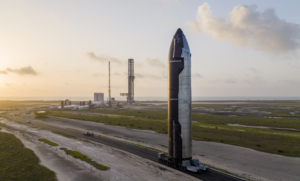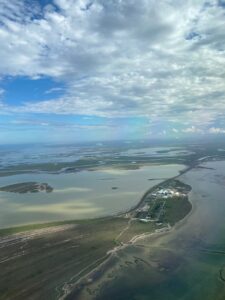
SpaceX Is Aiming To Launch A Falcon 9 Every 2.5 Days
Already in 2023, SpaceX has launched 61 total times, matching the record year in 2022 with 4 months left. At this rate, the company will come close to 90 launches in 2023 marking a new first and putting more payload mass in orbit than many other agencies and companies combined. Despite this record-breaking pace, the company has plans to increase it by a substantial margin and very soon as well.
For most of this year, SpaceX has averaged a launch every 4 days or so. New comments from Musk suggest the company will attempt to lower that number to 3 days by the end of the year, and a launch every 2.5 days by next year. At that point, SpaceX would be pushing its launch infrastructure among other things to the absolute limit.
Whether its booster reusability, available drone ships, Falcon second stages, etc. in order to launch that frequently, SpaceX will need to perfect every aspect of the launch process with no room for error. Here I will go more in-depth into this year’s launch record, the plan to increase it in the coming months, the pressure on launch infrastructure, and more.
Record Launch Cadence

Yesterday SpaceX launched the Space Development Agency’s Second Tranche 0 mission marking the 61st launch this year. That also marks the number of launches SpaceX completed in the entirety of 2022, which was a record in itself. Another mission is scheduled to happen tonight meaning the record could be broken if successful. Yesterday Elon Musk tweeted saying, “Great work by the @SpaceX team successfully launching 61 Falcon rocket missions this year! If tomorrow’s mission goes well, we will exceed last year’s flight count. SpaceX has delivered ~80% of all Earth payload mass to orbit in 2023. China is ~10% & rest of world other ~10%.”
This helps put in perspective the significance of these launch numbers and the degree to which SpaceX is leading within the industry. Looking at a chart of Falcon launches going back to 2010, you can see the growth over time. The first 6 years or so saw launches in the single digits before the cadence really started to pick up in 2017. Impressively SpaceX managed to nearly double the launches from 2021 to 2022. As partially mentioned prior, if SpaceX continues at its current pace or increases it, they should be around 90 launches at the end of the year. This would be a 50% increase from 2022.
As far as how they have managed this, it comes down to a bunch of different factors including Booster reusability, increased demand, constant manufacturing, and much more. The Falcon Heavy for example has contributed to this record by having an impressive year itself. Already it has launched 3 times this year with another two scheduled before 2024. Starlink has also played a very big role. SpaceX hasn’t been launching just to launch, but has either filled the Falcon 9 with commercial payloads or Starlink satellites. Starlink provided the extra demand necessary to literally always have a payload available so long as the rocket is ready. By now around 4,600 Starlink satellites are in orbit with another 37,000 or so waiting to be launched. While Starship is expected to help that process in the future, there still is plenty of time for the Falcon 9 to help out.
The other obvious contributor is booster reusability. While saving money by not destroying the boosters is a great benefit, arguably the more important is the impact on launch cadence. Refurbishing a booster is a much quicker process than making a new one. Combine this with the company’s determination and they have managed to continue pushing what’s possible regarding launch frequency.
To add to this, Elon also just tweeted pointing out, “Aiming for 10 Falcon flights in a month by end of this year, then 12 per month next year.” This tweet is actually a very big deal. So far this year SpaceX has averaged around 7.6 launches a month or one every 4 days. An increase in just around 4 to 5 months to 12 per month is ambitious. At that rate, SpaceX would be launching around 144 times a year. This is technically possible, but it comes with its own challenges.
Infrastructure Pressure

Launching missions involves much more than just the rocket itself. Specifically for SpaceX, they need to keep up on upper-stage manufacturing, drone ship placement, range bandwidth, and much more. Focusing on just one of these important pieces reveals the difficulty the company will face.
SpaceX has three operational drone ships. Of Course I Still Love You is based at the Port of Long Beach to support West Coast launches from Vandenberg. Just Read The Instructions is based at Port Canaveral and began operations in the Atlantic in June 2020. Finally, A Shortfall of Gravitas is based at Port Canaveral to support east coast recovery operations. In relation to this, SpaceX launches from three different sites, two on the East Coast and one on the West Coast.
On average, it takes about a week for the drone ships to land a booster at sea, return to land, drop off the booster, and return to position for another launch. With only three drone ships this conflicts a bit with the launch frequency that SpaceX will attempt to meet. This being said, SpaceX doesn’t need to land boosters on drone ships. In order to meet this frequency goal, we will likely see more Falcon boosters return to the launch site for a landing on the ground. A mix of these landing profiles with the drone ships could support a launch every 2.5 days.
Landing Zone 1 and Landing Zone 2, also known as LZ-1 and LZ-2 respectively, are landing facilities on Cape Canaveral Space Force Station for recovering components of SpaceX’s reusable launch vehicles. Landing Zone 1 is the most commonly used out of the two for occasional Falcon 9 launches. LZ-2 is usually only used when LZ-1 is occupied or during a Falcon Heavy launch where two boosters land at the same time. Since 2015, the two landing pads combined have facilitated over 30 different boosters’ landings across of host of different missions.
Around two months ago SLD 45 clarified that “as part of the SLD 45 allocation strategy, Phantom and Vaya Space will be the only users of SLC-13 once the real property agreement is executed.” In other words, SpaceX appears to be ending their use of Landing Zones 1 and 2 in the not too distant future. In an official document its quoted saying, “Through the LPAS, the U.S. Space Force and SLD 45 have selected four companies for allocation of launch property at Space Launch Complex (SLC) 15 to ABL Space, SLC 14 to Stoke Space, and SLC 13 to Phantom Space and Vaya Space.” This document and statement were released on March 7th 2023.
Originally, LZ-1 and LZ-2 were built on land leased in February 2015, on the site of the former Cape Canaveral Launch Complex 13. SpaceX built Landing Zone 2 at the facility to have a second landing pad, allowing two Falcon Heavy boosters to land simultaneously. The previous site was replaced by two circular landing pads 282 feet (86 m) in diameter and marked with a stylized X from the SpaceX company logo.
As far as what exactly this lease ending means for the future, it’s unclear as of right now. Many believe that SpaceX will begin building landing pads on one of the existing launch sites at the Cape. By now Falcon 9 landings have become
extremely reliable and consistent which could give the company confidence to land them closer to valuable infrastructure. Also, this could be considered a stepping stone for landings prior to work on Starship landing operations at LC-39A.
It’s important to point out that while SpaceX will move away from using LZ-1/2 at the Cape, word is that Falcon RTLS landings will not go away from Florida. SpaceX has its own plans to carry out that without the need to use Landing Zones 1 and 2. When the two landing pads were originally built, SpaceX was confident there would be at least a few failures and wasn’t sure exactly how well this booster landing process would work. A lot of things have changed since then that will impact the company’s decision. Based on the recent comments from Musk, however, they don’t seem to have any concerns related to the Falcon landing pads.
Besides places to land, the Falcon 9 upper stage is also a major factor. With the upper stage being expendable, SpaceX will need to have a new one ready every 2.5 days. This includes the fairings, engine, general structure, etc. Not to mention the fact that this pace will put even more pressure on the payload integration process which usually takes time.
SpaceX rockets also aren’t perfect 100% of the time and occasionally run into problems. For example, NASA and SpaceX officials recently approved the launch on Monday to proceed with preparations to launch the Crew-7 mission Friday, but only after formally signing off on several technical issues. One of those involved a drogue parachute that took longer than anticipated to fully inflate on a Dragon crew capsule returning from the space station earlier this year.
Stich said the other “special topic” discussed Monday was a valve failure on a Dragon cargo capsule in June. During that mission, an isolation valve in the Dragon’s propulsion system became stuck. SpaceX will need to work on each and every one of these factors in order to increase the Falcon launch frequency to a mission every 2.5 days.
Conclusion
SpaceX has already launched the same amount of Falcon missions in 2023 as the entirety of 2022. Between now and 2024 we should also expect to see an increase in launch cadence as the company works toward 12 missions a month. We will have to wait and see how it progresses and the impact it has on the space industry.



